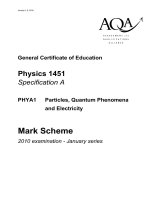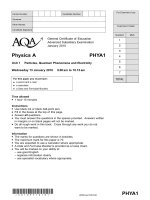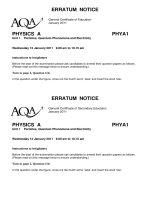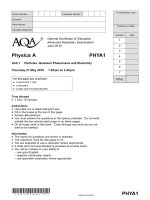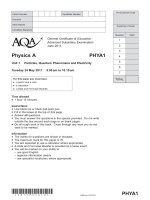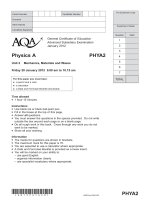- Trang chủ >>
- Khoa Học Tự Nhiên >>
- Vật lý
Vật lý A level:AQA PHYA2 w QP JAN11
Bạn đang xem bản rút gọn của tài liệu. Xem và tải ngay bản đầy đủ của tài liệu tại đây (867.11 KB, 16 trang )
WMP/Jan11/PHYA2
PHYA2
Centre Number
Surname
Other Names
Candidate Signature
Candidate Number
General Certificate of Education
Advanced Subsidiary Examination
January 2011
Time allowed
l
1 hour 15 minutes
Instructions
l
Use black ink or black ball-point pen.
l
Fill in the boxes at the top of this page.
l
Answer all questions.
l
You must answer the questions in the spaces provided. Do not write
outside the box around each page or on a blank page.
l
Do all rough work in this book. Cross through any work you do not
want to be marked.
Information
l
The marks for questions are shown in brackets.
l
The maximum mark for this paper is 70.
l
You are expected to use a calculator where appropriate.
l
A Data and Formulae Booklet is provided as a loose insert.
l
You will be marked on your ability to:
– use good English
– organise information clearly
– use specialist vocabulary where appropriate.
For this paper you must have:
l
a pencil and a ruler
l
a calculator
l
a Data and Formulae Booklet.
Physics A PHYA2
Unit 2 Mechanics, Materials and Waves
Monday 17 January 2011 1.30 pm to 2.45 pm
MarkQuestion
For Examiner’s Use
Examiner’s Initials
TOTAL
1
2
3
4
5
6
7
(JAN11PHYA201)
WMP/Jan11/PHYA2
Do not write
outside the
box
Answer all questions in the spaces provided.
1 A type of exercise device is used to provide resistive forces when a person applies
compressive forces to its handles. The stiff spring inside the device compresses as
shown in Figure 1.
Figure 1
1 (a) The force exerted by the spring over a range of compressions was measured.
The results are plotted on the grid below.
(02)
2
spring
compression
force exerted
by person
force exerted
by person
metal tubes
handles
∆ L
0
0.00 0.10 0.20 0.30 0.40
0.05 0.15 0.25 0.35
200
400
force
/ N
100
300
500
compression, ∆ l/m
WMP/Jan11/PHYA2
Do not write
outside the
box
1 (a) (i) State Hooke’s law.
(2 marks)
1 (a) (ii) State which two features of the graph confirm that the spring obeys Hooke’s law over
the range of values tested.
(2 marks)
1 (a) (iii) Use the graph to calculate the spring constant, stating an appropriate unit.
answer =
(3 marks)
1 (b) (i) The formula for the energy stored by the spring is
Ε
= FΔL
Explain how this formula can be derived from a graph of force against extension.
(3 marks)
Question 1 continues on the next page
(03)
3
Tur n over
ᮣ
1
2
WMP/Jan11/PHYA2
Do not write
outside the
box
1 (b) (ii) The person causes a compression of 0.28m in a time of 1.5 s. Use the graph in part (a)
to calculate the average power developed.
answer = W
(3 marks)
2 In a castle, overlooking a river, a cannon was once employed to fire at enemy ships.
One ship was hit by a cannonball at a horizontal distance of 150 m from the cannon as
shown in Figure 2. The height of the cannon above the river was 67 m and the
cannonball was fired horizontally.
Figure 2
2 (a) (i) Show that the time taken for the cannonball to reach the water surface after being fired
from the cannon was 3.7 s. Assume the air resistance was negligible.
(2 marks)
(04)
4
13
Not drawn to scale
67 m
path of
cannonball
150
m
cannon
ship
WMP/Jan11/PHYA2
Do not write
outside the
box
2 (a) (ii) Calculate the velocity at which the cannonball was fired. Give your answer to an
appropriate number of significant figures.
answer = m s
–1
(2 marks)
2 (a) (iii) Calculate the vertical component of velocity just before the cannonball hit the ship.
answer = m s
–1
(2 marks)
2 (a) (iv) By calculation or scale drawing, find the magnitude and direction of the velocity of the
cannonball just before it hit the ship.
velocity = m s
–1
direction =
(4 marks)
2 (b) (i) Calculate the loss in gravitational potential energy of the cannonball.
mass of the cannonball = 22 kg
answer = J
(1 mark)
(05)
5
Tur n over
ᮣ
WMP/Jan11/PHYA2
Do not write
outside the
box
(06)
6
2 (b) (ii) Describe the energy changes that take place from the moment the cannonball leaves the
cannon until just before it hits the water. Include the effects of air resistance.
(2 marks)
3 A single slit diffraction pattern is produced on a screen using a laser. The intensity of
the central maximum is plotted on the axes in Figure 3.
Figure 3
3 (a) On Figure 3, sketch how the intensity varies across the screen to the right of the central
maximum.
(2 marks)
3 (b) A laser is a source of monochromatic, coherent light. State what is meant by
monochromatic light
coherent light
(2 marks)
13
light intensity
central
maximum
first
minimum
position on screen
WMP/Jan11/PHYA2
Do not write
outside the
box
3 (c) Describe how the pattern would change if light of a longer wavelength was used.
(1 mark)
3 (d) State two ways in which the appearance of the fringes would change if the slit was
made narrower.
(2 marks)
3 (e) The laser is replaced with a lamp that produces a narrow beam of white light. Sketch
and label the appearance of the fringes as you would see them on a screen.
(3 marks)
Turn over for the next question
7
(07)
10
Turn over
ᮣ
WMP/Jan11/PHYA2
(08)
Do not write
outside the
box
8
There are no questions printed on this page
DO NOT WRITE ON THIS PAGE
ANSWER IN THE SPACES PROVIDED
WMP/Jan11/PHYA2
Do not write
outside the
box
4 Figure 4 shows a stationary wave on a string. The string is tied onto a thin metal bar
at A and fixed at B. A vibration generator causes the bar to oscillate at a chosen
frequency.
Figure 4
Explain how a stationary wave is formed. Then describe the key features of the
stationary wave shown in Figure 4.
The quality of your written answer will be assessed in this question.
(6 marks)
9
(09)
6
Turn over
ᮣ
metal bar
oscillations
AB
string
clamp
1.2
m
WMP/Jan11/PHYA2
Do not write
outside the
box
5 In the 1969 Moon landing, the Lunar Module separated from the Command Module
above the surface of the Moon when it was travelling at a horizontal speed of 2040 ms
–1
.
In order to descend to the Moon’s surface the Lunar Module needed to reduce its speed
using its rocket as shown in Figure 5.
Figure 5
5 (a) (i) The average thrust from the rocket was 30 kN and the mass of the Lunar Module was
15100 kg. Calculate the horizontal deceleration of the Lunar Module.
answer = m s
–2
(2 marks)
5 (a) (ii) Calculate the time for the Lunar Module to slow to the required horizontal velocity of
150ms
–1
. Assume the mass remained constant.
answer = s
(2 marks)
10
(10)
direction of
Moon’s surface
direction of
motion
Lunar
Module
rocke
t
WMP/Jan11/PHYA2
Do not write
outside the
box
5 (b) The rocket was then used to control the velocity of descent so that the Lunar Module
descended vertically with a constant velocity as shown in Figure 6. Due to the use of
fuel during the previous deceleration, the mass of the Lunar Module had fallen by 53%.
Figure 6
acceleration due to gravity near the Moon’s surface = 1.61 m s
–2
5 (b) (i) Draw force vectors on Figure 6 to show the forces acting on the Lunar Module at this
time. Label the vectors.
(2 marks)
5 (b) (ii) Calculate the thrust force needed to maintain a constant vertical downwards velocity.
answer = N
(2 marks)
5 (c) When the Lunar Module was 1.2 m from the lunar surface, the rocket was switched off.
At this point the vertical velocity was 0.80 m s
–1
. Calculate the vertical velocity at
which the Lunar Module reached the lunar surface.
answer = m s
–1
(2 marks)
Turn over for the next question
11
(11)
10
Turn over
ᮣ
direction of
Moon’s surface
WMP/Jan11/PHYA2
Do not write
outside the
box
6 A cable car system is used to transport people up a hill. Figure 7 shows a stationary
cable car suspended from a steel cable of cross-sectional area 2.5 × 10
–3
m
2
.
Figure 7
6 (a)The graph below is for a 10 m length of this steel cable.
6 (a) (i) Draw a line of best fit on the graph. (2 marks)
6 (a) (ii) Use the graph to calculate the initial gradient, k, for this sample of the cable.
answer = Nm
–1
(2 marks)
12
(12)
cable
cable car
0.0
0.0 2.0 4.0 6.0
extension
/ 10
–3
m
1.0 3.0 5.0 7.0
1.0
2.0
load
/
10
5
N
0.5
1.5
2.5
3.0
WMP/Jan11/PHYA2
Do not write
outside the
box
6 (b) The cable breaks when the extension of the sample reaches 7 0 mm. Calculate the
breaking stress, stating an appropriate unit.
answer =
(3 marks)
6 (c) In a cable car system a 1000 m length of this cable is used. Calculate the extension of
this cable when the tension is 150 kN.
answer = m
(2 marks)
Turn over for the next question
13
(13)
9
Turn over
ᮣ
.
WMP/Jan11/PHYA2
Do not write
outside the
box
7 Figure 8 shows a layer of oil that is floating on water in a glass container. A ray of
light in the oil is incident at an angle of 44
ο
on the water surface and refracts.
Figure 8
The refractive indices of the materials are as follows.
refractive index of oil = 1.47
refractive index of water = 1.33
refractive index of the glass = 1.47
7 (a) Show that the angle of refraction
θ
in Figure 8 is about 50°.
(2 marks)
7 (b) The oil and the glass have the same refractive index. On Figure 8, draw the path of the
light ray after it strikes the boundary between the water and the glass and enters the
glass. Show the value of the angle of refraction in the glass.
(2 marks)
14
(14)
glass container
glass
water
oil
air
light
ray
44°
θ
Not to
scale
WMP/Jan11/PHYA2
Do not write
outside the
box
7 (c) Explain why the total internal reflection will not occur when the ray travels from water
to glass.
(1 mark)
7 (d) Calculate the critical angle for the boundary between the glass and air.
answer = degrees
(2 marks)
7 (e) On Figure 8, complete the path of the ray after it strikes the boundary between the glass
and air.
(2 marks)
END OF QUESTIONS
15
(15)
9
Do not write
outside the
box
16
(16)
There are no questions printed on this page
DO NOT WRITE ON THIS PAGE
ANSWER IN THE SPACES PROVIDED
WMP/Jan11/PHYA2
Copyright © 2011 AQA and its licensors. All rights reserved.
